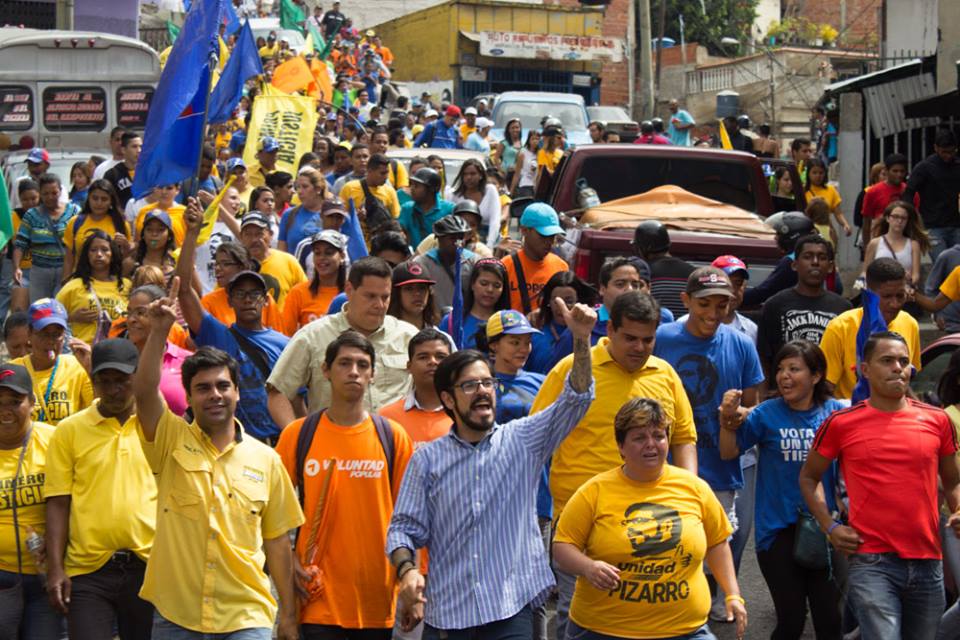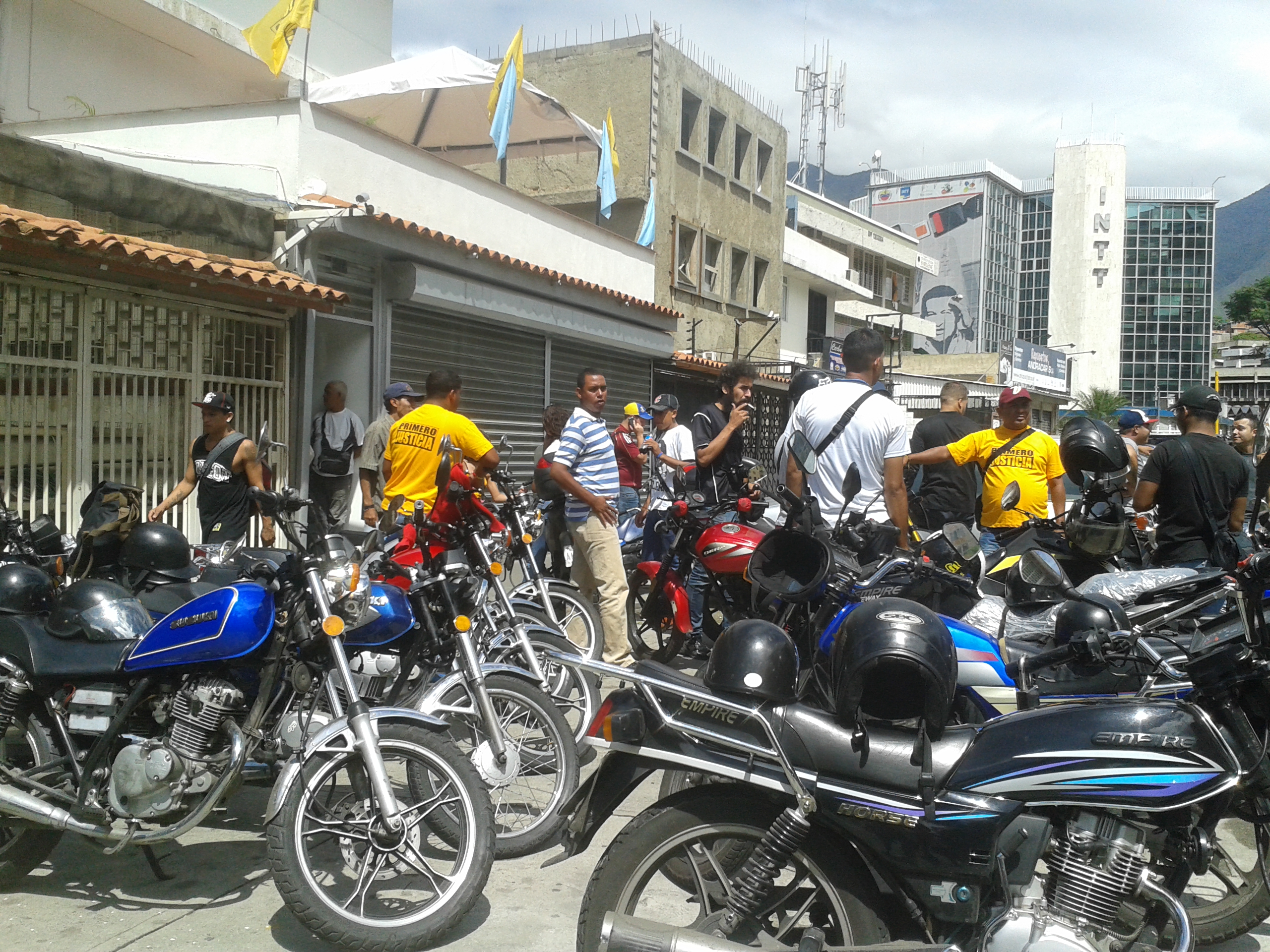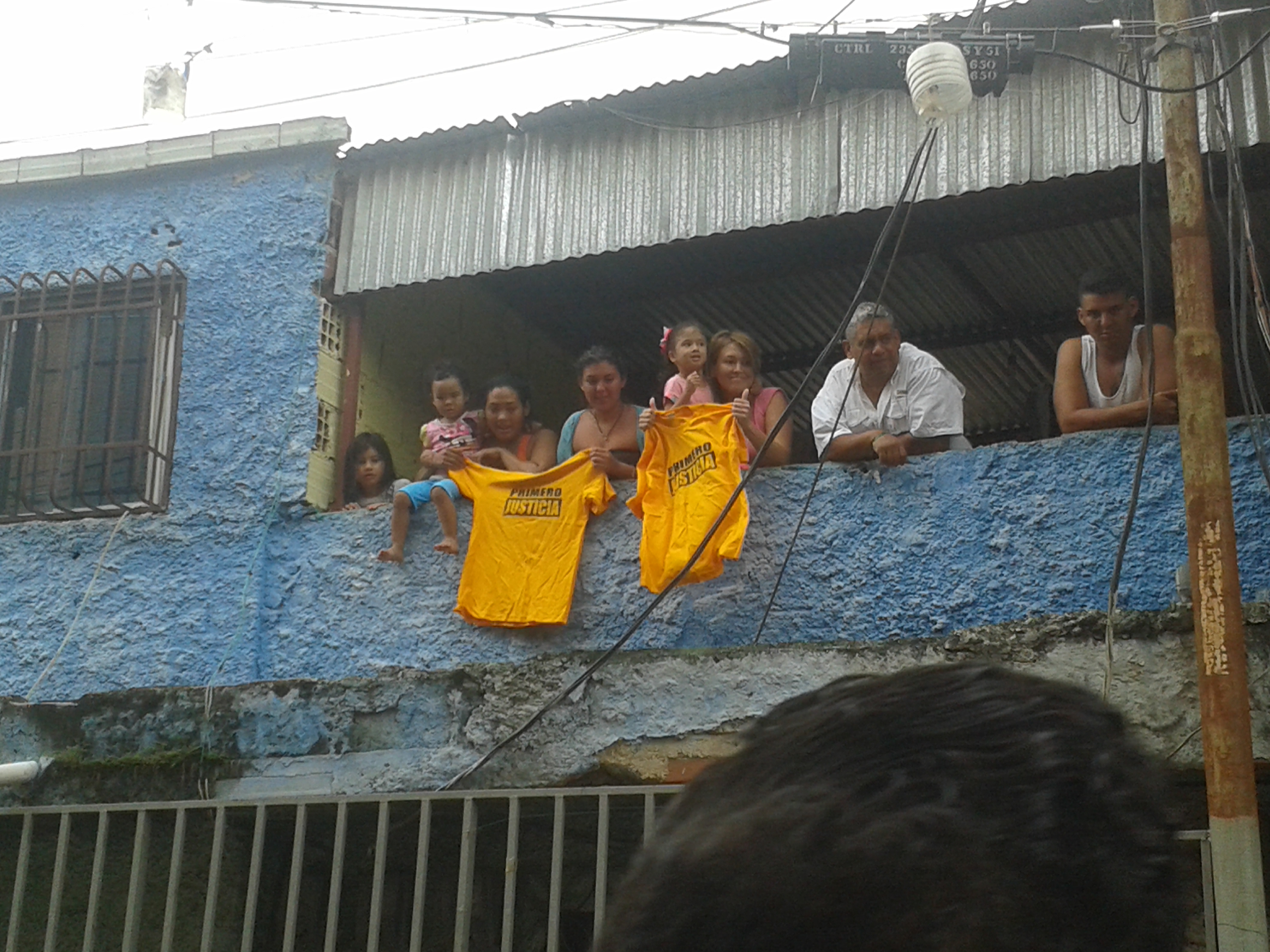Motorizado Rising: Riding with Miguel Pizarro's campaign
Lissette Gonzalez chronicles a day in the life of one of the opposition's most exciting campaigns, while holding on for dear life on a moto taxi.


During the 2014 protests against the government, chavista motorcycle gangs became a symbol of intimidation, repression and fear. Fast forward to the 2015 election campaign, and opposition legislator and current candidate Miguel Pizarro tours Petare’s slums escorted by a motorcycle gang of his own.
The Mesa de Unidad’s (MUD) campaign headquarters for the Miranda 3 circuit is located in La California, in a small warehouse on a ground floor and no identifying features except for the Primero Justicia and MUD flags waving from the balcony above. As I approach, I’m amazed by the 20 motorbikes parked just outside the entrance, waiting for the day’s tour to begin.
The candidate is 27 year old Miguel Pizarro. A former UCV student leader from the Generación del 2007, he made his name helping to organize protests against the chavista shut-down of opposition TV station RCTV. He was elected in 2010 as a alternate representative (suplente) from the state of Táchira before the National Assembly, and his profile has risen quickly as he’s established a reputation as a hard-working political activist with an inside line to Henrique Capriles.
His glasses and beard make him seem older than he really is, but I can still make out the tattoos on his forearms through the long sleeve blue shirt he always wears when campaigning. He certainly doesn’t look like a traditional Venezuelan político to me.
Inside headquarters, a campaign staff as young as Pizarro discusses the day’s route and assigns responsibilities. The under-furnished offices seem to be still under construction: stencil molds bearing Pizarro’s face and slogan are propped up against the whitewashed walls. Motorcycle helmets are the only decoration over the cornice in front of the stairway.
Time is up and everyone in the office gets on a moto taxi. I put on my helmet and nervously join the group of 20 bikers, who are all wearing yellow t-shirts with Miguel Pizarro’s face; some of them hold flags. They seem at ease riding across the Francisco de Miranda Avenue and turning south onto Río de Janeiro. Meanwhile, I grab on to my biker in terror (almost like a sweetheart hug), trying not to fall.
Middle-class people tend to think of ‘Petare’ as a giant, homogenous shantytown, but petareños don’t talk about it that way. Each section of slum is considered a separate barrio, with its own identity and concerns, its own community leaders and culture.
Today, we begin in one of the older, more established barrios in Petare, El Carpintero. Located atop a hill on the southeast corner of Petare, El Carpintero is known for its sizable proportion of Colombian residents who came to Venezuela decades ago. In the past few years El Carpintero has also fallen victim to violent crime, and its neighbors are terrorized by local thugs and drug gangs.
We exit to La Línea Street and begin climbing up towards the spot in El Carpintero where the candidate’s walkabout will start. Here’s where things get scary; streets are narrow and winding, and several times traffic has to be stopped so we can pass. At the designated meeting spot, local activists and a truck with huge speakers are waiting. Soon the recording blares: “aquí viene Miguel Pizarro, el candidato del cambio.” The music begins and the crowd gathers around the downhill procession, and we begin to walk.
He says that if the country reacts the same way Petare does, change will be unstoppable. Change that won’t come from a messiah, but from the people’s will and organization.
Once the candidate and our group are dropped off, the squad of moto taxis rush off to wait at the spot where the march is slated to end to take us back toheadquarters. They get paid for this job, but not as much as they would make on a regular working day selling moto taxi rides. They stay because they want to, because they also want a political change. Alongside the group, a 12 year-old girl rides her scooter beside her dad. She doesn’t want to miss the action.
The candidate walks at a fast pace while music blares, flags wave and people blow whistles. He waves to the public and stops now and then to shake a neighbor’s hand. Pizarro tells me this is the third time he walks through this community. The first was months ago, and he spent 3 to 4 hours going door to door, listening to local problems and reaching out to neighborhood leaders. On his second visit, he went to meeting places between sectors, and he’s now walking with all those followers as a show of strength. There are no signs of pro-government colectivos during the tour, not a single intimidation attempt.
As the opposition march makes its way downhill, the barrio changes. Up in El Carpintero ranchos made of wooden boards predominate, but as you approach Mesuca, houses are better built, formal shops appear beside a sport center with a pool and playground, built by Primero Justicia’s Mayor Ocariz.
The diversity in living conditions is plain to see. The tour passes in front of a Barrio Adentro CDI (the central government-built medical diagnostics center) and people waiting outside wave their hands to the candidate. In each sector a new group of local activists joins the crowd.
The walk ends at El Carmen, in Barrio Unión. Next to the El Carmen Church there is a small square along with a clinic and pharmacy set up by Fundasucre, a municipally funded social program. There, a stand is already set up and playing music as campaign workers hand out soft drinks and snacks for those arriving with the march.
Pizarro steps in and greets everybody. He tells me he believes personal contact is very important. To make political change happen, being different is not only about wearing a different color, but about acting differently: being close to people, knowing about their problems, and focusing on organization. Shut out from broadcast media coverage, political campaigns need to be done in a different way, so he gives priority to walking around the circuit’s streets and broadcast his message through social networks. Today his strategy appears to be working.
As we get back on our moto taxis to return to La California, we leave behind a festive crowd. Local activists dance, and the march has turned into a party. Across the street a house has a sign that reads “Colectivo Barrio es Unión”. The door remains closed.

The candidate
When we reach headquarters, the mototaxis have finished their job and leave until the next day. Now that his work has ended for the day, I ask Pizarro about the campaign, and he says this circuit is like a tiny Venezuela: wealthy areas like Urbanización Miranda, struggling middle class sectors like La California, and low-income sectors as the Petare slums.
He says that if the country reacts the same way Petare does, change will be unstoppable. He says change won’t come from a messiah, but from the people’s will and organization. That’s the kind of democracy he is committed to, while he lives a normal life in his rented apartment and riding a motorbike to get through the traffic as so many Caraqueños do.
He is a political leader who doesn’t want to be distant from the common people’s problems. We’ll see if this is what Petare’s citizens are willing to vote for.
Caracas Chronicles is 100% reader-supported.
We’ve been able to hang on for 22 years in one of the craziest media landscapes in the world. We’ve seen different media outlets in Venezuela (and abroad) closing shop, something we’re looking to avoid at all costs. Your collaboration goes a long way in helping us weather the storm.
Donate






